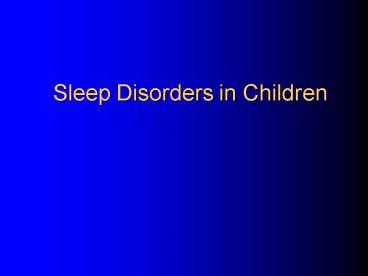Sleep Disorders in Children - PowerPoint PPT Presentation
1 / 25
Title:
Sleep Disorders in Children
Description:
Each sleep cycle takes about 90 minutes. ... You can be your best when you get enough good sleep! ... Some things can keep you from getting a good night's sleep. ... – PowerPoint PPT presentation
Number of Views:2369
Avg rating:3.0/5.0
Title: Sleep Disorders in Children
1
Sleep Disorders in Children
2
Sleep Cycles Nature is full of cycles.As the
Earth rotates we have cycles of sunlight and
darkness. The moon has cycles. We also have
cycles in our sleep. There are 5 stages in one
sleep cycle. Each sleep cycle takes about 90
minutes.
3
(No Transcript)
4
Sleep and You You can be your best when you get
enough good sleep! Kids ages 5 to 12 need 10 to
11 hours of sleep each night.When you get enough
sleep you can Pay attention better in school
Be creative and think of new ideas Fight
sickness so you stay healthy Be in a good mood
Get along with friends and family Solve
problems better Without enough sleep you can
Forget what you learned Have trouble making
good choices Be grumpy and in a bad mood Have
trouble playing games and sports Be less patient
with brothers, sisters, and friends Have trouble
listening to parents and teachers
5
Why We Sleep Sleep helps our body and brain
develop and grow.
6
Can't Sleep?Most people have trouble sleeping
once in awhile. Some things can keep you from
getting a good night's sleep. But there are lots
of things you can do to help yourself sleep well.
7
Sleep TipsHere are some things you can do to
help get a good night's sleep.
8
Sleep TrapsHere are some things that can keep
you from getting a good night's sleep.
9
DreamsEveryone dreams!
Scientists are not sure why we dream or what we
dream. They do know that R.E.M. sleep is
important for learning and memory. TV shows,
video and computer games, real people, and actual
events can show up in your dreams. Your dreams
may be related to how you feel, your worries,
your hopes, or things you are excited about.
10
Nightmares
Keep a dream journal. When you wake up, write
about or draw dreams you remember in your special
journal. Have fun trying to figure out what your
dreams mean!
11
Stages of SleepSWS and REM
12
The EEG Rollercoaster
13
Age/Sleep Time
14
Age and Sleep Time
15
Age and REM Sleep
16
Normal Sleep Patterns and Requirements
- Newborns- sleep 16 to 18 hours a day, usually
seven sleep periods. - Infants- sleep 22 hours a day,20-30 REM sleep.
- Toddlers- 10-12 hours a day, 20-30 REM sleep.
- Preschoolers- 11-12 hours of sleep per night
- School Aged children- 8-12 hours at night.
17
Continued
- Adolescents- 8-10 hours of sleep
- Young adults- 7-8 hours, may require less
- Middle Aged Adults- 6-8 hours per night
- Older Adults- 6 hours
18
Common Sleep Disorders
- Primary Sleep disorders- those in which the
persons sleep problem is the main disorder. - Secondary Sleep disorder- sleep disturbance
caused by another clinical disorder, such as
thyroid dysfunction, depression , or alcoholism.
19
Primary Sleep Disorders
- Insomnia- most common sleep disorder, inability
to obtain an adequate amount or quality of sleep. - Hypersomnia- Opposite of insomnia, excessive
sleep, especially daytime. - Narcolepsy- Sudden wave of overwhelming
sleepiness that occurs during the day. Referred
to as sleep attack.
20
Continued
- Sleep Apnea- periodic cessation of breathing
during sleep. - Parasomnias- Behavior that may interfere with
sleep. (somnambulism (sleep walking), sleep
talking, Nocturnal enuresis, nocturnal erections,
bruxism). - Sleep Deprivation- prolonged disturbance results
in decreases amount, quality, consistency of
sleep.
21
Assessment of Sleep
- Assessment relative to a clients sleep includes
a sleep history, sleep diary, a physical
examination, and a review of diagnostic studies.
22
Sleep History
- Usual sleeping pattern, specifically sleeping and
waking times, hours of undisturbed sleep, etc. - Bedtime rituals
- Use of sleep medications
- Sleep environment
- Changes in sleep pattern
23
Sleep Diary
- Written record to be much more precise
- Total number of sleep hours a day
- Activities performed 2-3 hours before sleep
- Bedtime rituals
- Any worries that may affect clients sleep
- Factors that client believes to be positive or
negative towards sleep
24
Sleep Laboratory Evaluation
- Polysomnographic Studies (sensors)
- EEG (brain waves)
- EKG (heart rhythms)
- Eye movement (above/below eye)
- Leg movements
- Breathing (under nose, near mouth)
- Breathing effort and chest movement
- Oxygen levels (finger sensor)
- Night or daytime
25
Treatment
- Major goal for clients with sleep disturbances
is to maintain a sleeping pattern that provides
sufficient energy for daily activities.































